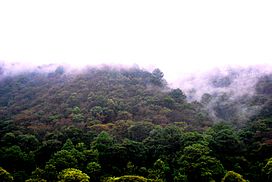Central American pine–oak forests facts for kids
Quick facts for kids Central American pine–oak forests |
|
|---|---|

Pine-oak forest in Chimaltenango, Guatemala
|
|
 |
|
| Ecology | |
| Realm | Neotropical |
| Biome | Tropical and subtropical coniferous forests |
| Borders |
List
|
| Geography | |
| Area | 111,400 km2 (43,000 sq mi) |
| Countries | |
| Conservation | |
| Conservation status | Critical/Endangered |
| Global 200 | Yes |
| Protected | 11.67% |
The Central American pine–oak forests are a special type of forest found in the mountains of northern Central America and the Chiapas state in southern Mexico. These forests are known for their many pine and oak trees.
Contents
Where Are These Forests Found?
These amazing forests cover about 111,400 square kilometers (about 43,000 square miles). They stretch along the mountain ranges of Central America. You can find them starting in the Sierra Madre de Chiapas mountains in Mexico. From there, they go through the highlands of Guatemala, El Salvador, and Honduras, all the way to central Nicaragua.
These pine-oak forests usually grow at heights between 600 and 1,800 meters (about 2,000 to 5,900 feet) above sea level. If you go lower down the mountains, these forests change. On the side facing the Caribbean Sea, they turn into tropical moist forests. On the side facing the Pacific Ocean and in inner valleys, they become tropical dry forests. Higher up, above 1,800 meters (about 5,900 feet), you often find cloud forests.
What Plants Grow Here?
The Central American pine–oak forests are mostly filled with different kinds of pine trees (Pinus species) and oak trees (Quercus species). You'll see more pines at higher elevations and more oaks at lower elevations.
Some common pine trees include Pinus chiapensis and Pinus ayacahuite. Among the oaks, you might find Quercus corrugata and Quercus oleoides. You can also often spot the American sweetgum tree (Liquidambar styraciflua) growing alongside the pines and oaks.
These forests are also home to trees usually found further north in North America. This includes types of fir (like Abies guatemalensis), cypress (Cupressus lusitanica), and ash trees.
What Animals Live Here?
These forests are full of interesting animals!
Mammals
Many mammals call these forests home. You might find big cats like the jaguar (Panthera onca), puma (Puma concolor), and ocelot (Leopardus pardalis). Other cool animals include the Baird's tapir (Tapirus bairdii), which looks a bit like a pig with a short trunk. There are also monkeys like the Central American spider monkey (Ateles geoffroyi) and the mantled howler monkey (Alouatta palliata).
Birds
The mountains in this area are very important for birds. Many unique and rare birds live here. Some resident birds you might see are the bearded screech owl (Megascops barbarus), the pink-headed warbler (Cardellina versicolor), and the blue-throated motmot (Aspatha gularis).
These pine-oak forests also provide a warm winter home for many birds that fly south from colder parts of North America. This includes birds like the golden-cheeked warbler (Dendroica chrysoparia).
Protected Areas
About 11.67% of these forests are protected areas. This means they are special places set aside to keep the plants and animals safe.
Here are some of the important protected areas in each country:
- El Salvador
- Guatemala
- Cerro del Baúl National Park
- El Pital Biological Reserve
- Laguna Lachuá National Park
- Cuenca del Lago Atitlán Multiple Use Area
- Honduras
- Celaque National Park
- Cerro Azul Meámbar National Park
- La Tigra National Park
- Río Plátano Biosphere Reserve (This is a World Heritage Site!)
- Mexico
- El Triunfo Biosphere Reserve
- Lagunas de Montebello National Park
- Sumidero Canyon National Park
- Nicaragua
- Cerro Apante Nature Reserve
- Cerro Datanlí–El Diablo Nature Reserve
- Somoto Canyon National Monument
Some of these protected areas are also recognized internationally. For example, the Río Plátano Biosphere Reserve in Honduras is a World Heritage Site. This means it's considered very important for everyone in the world to protect!
See also
 In Spanish: Bosques de pino-encino de América Central para niños
In Spanish: Bosques de pino-encino de América Central para niños
- List of ecoregions in Mexico
- List of ecoregions in Guatemala
- List of ecoregions in El Salvador
- Ecoregions of Central America
- Trees of Central America

